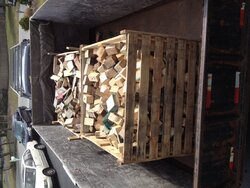I'm going experiment with these.
They are from broken down pallets. The pallet manufacturing facility has skids of them out front, free for the taking, plus skids of broken down pallets.
The owner wasn't there today, but I am going to go back and ask if they could put a few skids of this stuff or the pallet wood on my trailer.
If the blocks don't work well, the broken down pallets certainly will. I can use it to heat the DHW over the summer and save the good wood for winter heat.
Has any had any experience with these types of blocks?
They look like giant pellets.
They are shredded wood fibers, most likely held together by some type glue or polymer.

They are from broken down pallets. The pallet manufacturing facility has skids of them out front, free for the taking, plus skids of broken down pallets.
The owner wasn't there today, but I am going to go back and ask if they could put a few skids of this stuff or the pallet wood on my trailer.
If the blocks don't work well, the broken down pallets certainly will. I can use it to heat the DHW over the summer and save the good wood for winter heat.
Has any had any experience with these types of blocks?
They look like giant pellets.
They are shredded wood fibers, most likely held together by some type glue or polymer.









